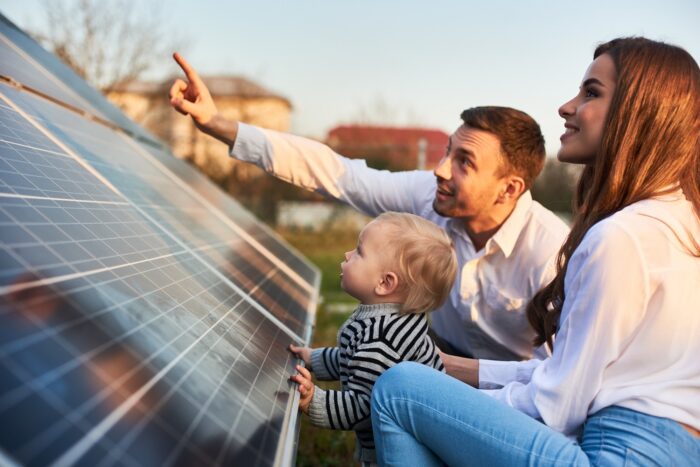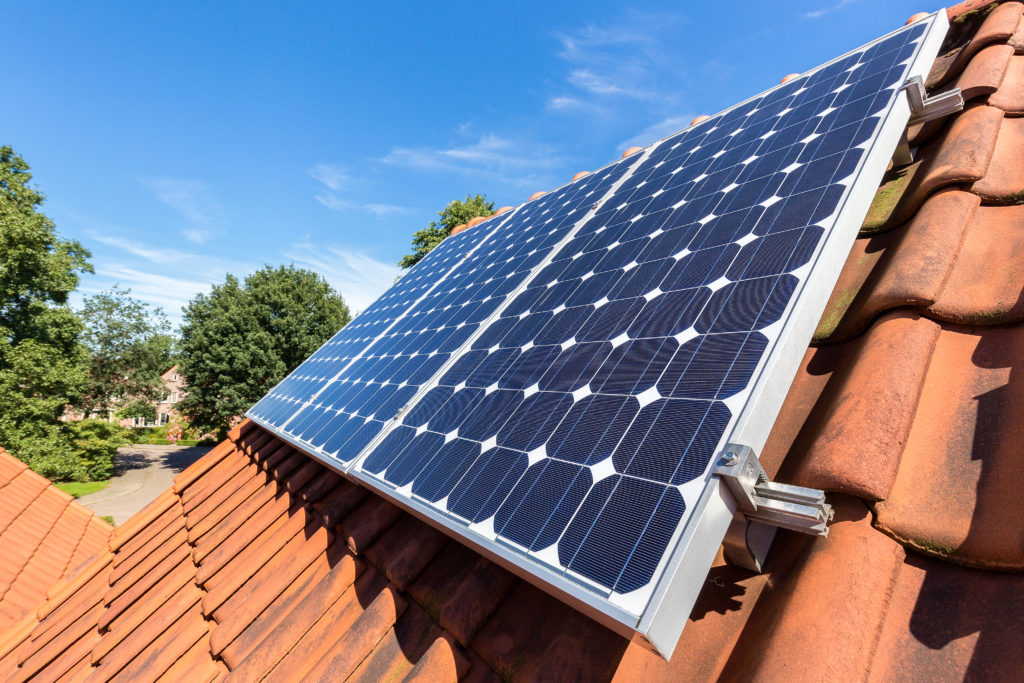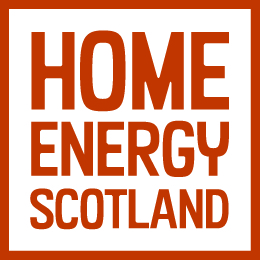Solar panels
Officially known as solar photovoltaic (or solar PV), solar panels catch the sun’s energy and convert it into electricity that we can use in our homes.

More people than ever before are looking for ways to generate their own electricity.
Solar panels give you this option, even in our cloudy Scottish climate. By generating your own electricity, you can reduce your electricity bills. You can also sell the electricity from your panels back to the grid, allowing you to both save and earn money at the same time.
Already have solar panels in your home? Our Living with solar panels guide has some great tips for getting the most out of your system.
What are solar panels?
Solar panels (officially known as solar photovoltaic, or solar PV) use light from the sun to generate free electricity. We can then use this electricity in our home, for everything from boiling a kettle to charging an electric vehicle.
Not only is the electricity from your panels free, it’s also renewable. So solar panels can help us save money whilst saving the planet.
How do solar panels work?
Each solar panel is made up of individual cells. There are usually 60 cells in each panel.
To generate electricity:
- Firstly, the sun shines on the solar panels
- Next, the cells in the panel absorb the sun’s energy
- Thirdly, this creates an electrical charge, which in turn creates DC (direct current) electricity
Since our homes run on AC (alternating current) electricity, the electricity from our panels must be converted before we can use it. For this, the solar PV system includes a device called an inverter. The inverters converts the DC electricity from our panels into AC electricity which we can then use in our home.
Pros and cons of solar panels
- Free electricity helps reduce your energy bills
- Renewable source of energy
- Long-lasting and low maintenance
- Relatively expensive
- Your roof needs to be big enough and face the right direction
- Battery storage is relatively expensive
Solar panels: what to consider
If you’re trying to work out whether or not to install solar panels, here are some things to consider.
Is my home suitable for solar panels?
To get the most out of solar PV, you’ll need to check that your home is suitable for solar power. This will depend on:
To get the most out of solar panels, they should be installed on a south-facing, unshaded roof. East or west-facing roofs can also be considered. We wouldn’t recommend putting solar panels on a north-facing roof. That’s because the amount of electricity they generate won’t cover very much of your energy needs.
Solar panels are fitted in groups known as ‘arrays’. The size of an average array is 4.5m x 4.5m. The larger your roof, the larger the array you can have fitted. The bigger the array, the more electricity you can generate.
If your roof is in the shade for most of the day, the solar panels won’t get enough daylight to generate much electricity. Chimneys, trees and other buildings are all things to look out for when considering solar panels on your roof.
You will likely need planning permission for solar panels if:
- You live in a listed building
- You live in a conservation area
- You live in a national park
To find out whether you need planning permission for solar panels, speak to your local authority.
Can I get solar panels if I live in a flat?
Yes, you can get solar panels if you live in a flat. Marc, from our EcoCosi team, took part in a webinar on exactly this topic, which you can check out at the link below.
In the video, Marc explores the benefits and challenges of the process to install solar panels on multi-tenancy blocks of flats, and how homeowners can overcome the barriers and decarbonise their home energy systems.
How many solar panels do I need?

The average system size in the UK is 3.5kWp (kilowatt peak). This typically works out as ten solar panels, taking up 10 – 20m2 of space.
It might be tempting to get as many solar panels installed as you can fit on your roof, but this usually only makes sense if:
- You have a battery to store excess electricity
- You are signed up to a tariff that pays you for exporting electricity to the grid
Without either of these options, a lot of the electricity collected from the solar panels is likely to be wasted.
The exact number of solar panels you need for your home really depends on how much electricity you’re trying to generate. Home Energy Scotland can help you get a better idea of your electricity needs based on your usage. Call them for free on 0808 808 2282 to speak to an energy advisor.
Registering your solar PV system
In most cases, your solar PV system will be connected to the national electricity grid. This means you’ve got the opportunity to sell any electricity you don’t use to the grid. It also means that you can still use electricity from the grid at times when your solar panels are not producing enough power, such as during night.
To connect your solar PV system to the grid you need to speak to the District Network Operator (DNO). This is the company that’s responsible for the grid in your local area.
- If you live in the north of Scotland, your DNO is Scottish and Southern Electricity Networks.
- If you live in central or southern Scotland, your DNO is SP Energy Networks.
The company that installs your solar panels usually registers the system with the DNO.
Should I get a solar diverter?
What is a solar diverter?
A solar diverter lets you store excess energy from your solar panels as hot water. It’s similar to battery storage (see below), except the “battery” is a hot water cylinder.
How does a solar diverter work?
With solar panels, you’ll usually hit peak generation in the early afternoon. At that point, if your panels generate more electricity than you’re using around the home, then you’ll lose the excess to the National electricity Grid.
However, a solar diverter helps you keep this excess energy in your home. It automatically uses surplus electricity to power an immersion heater. This immersion heater heats the water in a hot water cylinder. This means you’ve now got a source of free hot water in your home.
How much does a solar diverter cost?
The cost of a diverter varies according to both brand and features. Typically, a diverter will cost anywhere between £100 and £400. There will also be the installation cost to consider.
Should I get a solar diverter?
This will depend on the size of your solar PV system, as well as how much electricity you’re using during peak generation times. If you’re away from home during the afternoon, then it’s likely your home’s electricity usage will be low at this time. This means your panels will send a lot of their power to the National Grid. In such cases, it might be worth installing a solar diverter.
Solar panel battery storage
Our energy needs don’t stop when the sun goes down. This is why many people install a battery alongside their solar PV system. The energy the panels produce during the day is stored in battery. This can then be used during the evening and night-time.
A battery could be worthwhile if your panels produce significantly more energy than you use during the day. However, it might make more financial sense to sell this energy back to the national grid.
Batteries come in different sizes. The size you choose will depend on your energy usage and the amount of power your array is able to produce. If you want the power in the battery to get you through the night, you’ll need to have a look at your electricity usage during those hours.
For more advice on batteries, see our battery storage guide.
How much do solar panels cost?
A typical 3.5kWp (kilowatt peak) solar PV system costs around £7,000.
The exact cost will vary, depending on factors such as the size of your system and how easy it is to access your roof.
Different installers will quote different prices, therefore we’d suggest getting quotes from at least three installers. It’s also important to check that any installers you approach are registered with the Microgeneration Certification Scheme (MCS).
Smart Export Guarantee (SEG)
With a Smart Export Guarantee (SEG) scheme you get paid for sending your solar panel’s electricity to the national grid.
To get SEG payments, you’ll need to sign up to a specific SEG tariff with your energy company. All energy companies with over 150,000 customers must offer at least one SEG tariff.
The payments for SEG will vary depending on the tariff. Energy companies can set the payment per kilowatt hour at any price they choose, as long as it is above zero. To find out what SEG tariffs your energy supplier offers, you can check their website or contact them directly.
Grants for solar panels
There are currently no solar panel grants in Scotland that we are aware of. However, we’ll keep an eye out and update this page if funding becomes available.
Solar panels are sometimes offered through government-funded projects, such as Energy Efficiency Scotland: Area Based Schemes (EES: ABS). If there’s an EES ABS running in your area, your local council or one of their partners should write to you to let you know.
Solar Panel FAQs
Solar PV systems typically have long-life spans. You should expect the panels to last for around 25 years. You may need to replace the inverter which comes with the system after 10 years.
Solar panels generate DC (direct current) electricity. Before we can use this in our homes, it needs converting to AC (alternating current) electricity. This is the inverter’s job. If you have battery storage, it’s the inverter that sends DC electricity to the battery.
Solar panels are low maintenance and generally self-cleaning. We recommend that you keep them clean, and service your system approximately every two years.
Yes. If you have the space and there are no issues with shading, then ground-mounted solar panels could be the way to go.
Ground-mounted solar panels are usually more expensive to install than roof-mounted systems. However, since they can be installed at exactly the right angle, their output can be maximised.

Changeworks delivers Home Energy Scotland in the south east and Highlands and Islands on behalf of the Scottish Government and Energy Saving Trust.
As well as providing free, impartial expert advice to thousands of people every month to help them to keep warm in their homes for less, they identify funding opportunities for households seeking to install energy efficiency measures.
For more information, give Home Energy Scotland a call on 0808 808 2282 or email and the team will be happy to help you.
Useful pages
Is this page useful?